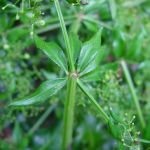| Common Name: |
Madder |
| Botanical Name: |
Rubia tinctorum |
| Genus: |
Rubia |
| Family: |
Rubiaceae |
| Native Location: |
SE Europe, W and C Asia. |
| Cultivation: |
Well-drained soil in sun or partial shade. Rubia tinctorum prefers light, dry soil, and thrives in alkaline conditions. |
| Propagation: |
By seed sown when ripe; by division in spring. |
| Harvest: |
Rhizomes and roots are lifted in autumn from plants at least three years old, and peeled and dried for decoctions and powders. Chinese herbalists also lift roots in spring. Whole plants, including roots, are lifted from two-year-old plants in spring or autumn for dye production. |
| Height: |
25cm-1m (10-36in) |
| Hardiness: |
Z6-10 |
| Warning: |
Internal use of madders stains urine, milk, and bones red |
| Parts Used: |
Roots |
| Properties: |
An antiseptic, diuretic, laxative herb that stimulates the liver and uterus, and relaxes spasms. |
| Medicinal Uses: |
Internally for kidney and bladder stones. Used in N African folk medicine for anemia and blood diseases, and as an aphrodisiac; also as a tonic, appetizer, and expectorant. Externally for wounds, ulcers, and sciatica. |
| Ecomonic Uses: |
Dried roots are used as a source of natural red, pink, orange, apricot, and purple dyes. Alizarin is used in making dyes, and yields pigments for inks and paints. |
| Bibliography: |
The Encylopedia of Herbs by Deni Brown Copyright © 1995, 2001. Dorling Kindersley Limited. pp 349-350 |

